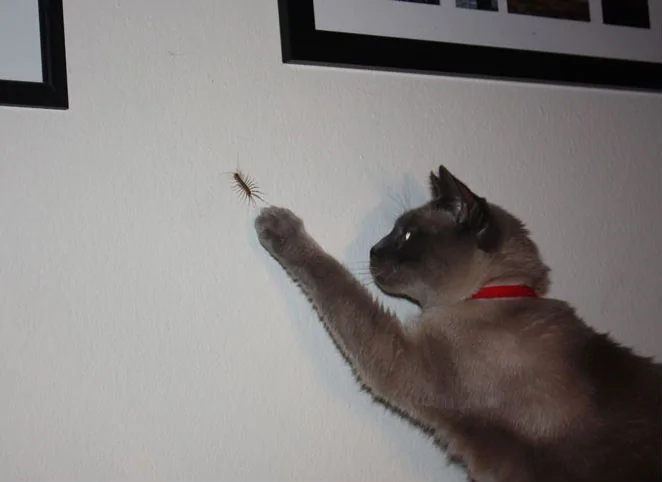It makes sense that when we spot an insect in our home, our first instinct might be to grab it and smash it.
Numerous of these organisms have toxic chemicals inside of them that can harm or even kill us.
Unusual snails that cause people the most anxiety include those with many legs, like centipedes. More panic and anxiety can be brought on by these tiny but terrifying-looking insects than by any other pest.
One might think twice about trying to end their life the next time they discover one gathered in their bathroom or bedroom.

Despite their frightening appearance, many centipedes are benign or even beneficial to humans. Other bugs that would otherwise cause havoc and harm to our homes are eaten by some species.
Furthermore, by understanding where these bugs come from and the types of environments they prefer, we can prevent them from ever entering our homes in the first place.
It’s normal to want to squash centipedes when you first see them scurrying around your house, and it makes sense given their alarming appearance.
We may want to change our minds and show our gratitude by not killing them in the future, though, once we realize how important these creatures are to our homes.
Surprisingly, these multi-legged creatures have prevented cockroaches, ants, and spiders from entering our homes.
Since centipedes are natural predators that eat those insects, they assist in controlling infestations and lowering the risk of disease transmission. They also consume eggs and larvae, preventing the reproduction of many bug species in your house.
Furthermore, these arthropods are unlikely to bother you or invade your living space because they rarely fly or jump.
Although centipedes make great friends, you shouldn’t throw open your doors and welcome them in large numbers. The next time they come over, you should instead extend a grace period to the one or two you find around the house.
In homes, one type of centipede that is distinct from its worm-like relatives may be discovered. Almost as small as a typical centipede, these tiny creatures have twenty legs covering their bodies.
Considering how hungry they are, these insects are vital to a house’s defense system. Cockroaches, spiders, silverfish, bedbugs, and ants can all be caught and eaten by them.
Despite the fact that they protect your home from potentially harmful insects, you shouldn’t let them roam freely inside.
It is better to ignore one or two of these centipedes and be grateful that they are keeping other bugs away rather than allowing them to multiply in large numbers.
If children or adults find spiders frightening or unattractive, they may make a loud noise when you approach them.
It’s better to gently lead them along or take them outside so they can eat some plants rather than simply crushing them.
Everyone avoids dealing with spiders because if you kill one, it might release a lot of tiny spider offspring into your home.
Centipedes are also more appealing. They are weak little creatures that can only frighten someone to death because they are too small to cause serious harm.
The fact that these arthropods want to live their lives and shouldn’t be killed when found, despite the fact that many people find their segmented bodies and numerous legs odd-looking, must always be kept in mind.
Centipedes and silverfish are not a cause for concern. However, unlike some other pests, despite their frightening appearance, they do not spread viruses throughout the entire house.
These species are typically non-lethal and harmless, though caution is advised when interacting with them.
But this is distinct from a lot of other pests. If you don’t seek medical attention right away, some insects have been known to result in serious health issues, and even death.
Knowing what kinds of pests to watch out for in your home is crucial as a result.
The deadliest insects to be on the lookout for are mosquitoes. These minuscule but obtrusive insects could spread illnesses like malaria, dengue fever, and the Zika virus, all of which can be fatal if untreated.
Ticks are another pest to be on the lookout for because they can spread Lyme disease and Rocky Mountain spotted fever, which can be fatal if not treated right away.
Then there are bees and wasps; while their stings are typically painful, they can occasionally result in life-threatening allergic reactions, so it is best to avoid them whenever possible.
The poisonous bites of fire ants have the potential to cause severe inflammation and even anaphylactic shock in susceptible individuals, making them potentially very dangerous.
While the majority of household pests aren’t harmful, it’s important to keep in mind that a small number of them can be harmful to our health if we aren’t careful or aware of them.

So, you’re closely monitoring any new pests that come into your house (or yard). Always do your research before acting in any unexpected or uncertain situation!
Those who are bitten by bullet ants often experience excruciating pain that mimics being shot.
These creatures, which belong to the giant ant family, are widespread in the Paraguayan and Nicaraguan jungles. Because of how powerful their venom is, it is best to avoid getting bitten.
Internal parasites called botfly larvae have the potential to infect both humans and other animals. When these eggs are implanted beneath the skin, they will begin to develop and change. In the tissue around them, this will result in alterations that eventually cause an infection.
Some parents assert that they felt one of these larvae inside their bodies. Topical, oral, and, in some cases, surgical medications may be used to treat this condition.
Blood-sucking parasites known as fleas can seriously itch, irritate, and infect humans.
Additionally, they have the ability to spread illnesses like murine typhus and the bubonic plague.
These pests reproduce quickly, making it difficult to keep their population under control. Flea bites should therefore be handled with care and treated appropriately.
When provoked, fire ants bite painfully. They are an aggressive ant species. They have 295 different types and can sting with venom, triggering allergic reactions in some people.
These stings can deliver venom that can cause weeks of swelling and pain. Because they spread quickly and can occupy sizable territories, fire ants have become a problem in many homes across the globe.
The kissing bug is well known for transmitting the parasite Trypanosoma cruzi through its bite. Because it can cause Chagas disease in humans, which can be fatal if untreated, this parasite is to blame for thousands of fatalities each year.
Infection can result from ingesting contaminated excrement from certain animals, such as cats and dogs, coming into direct contact with infected animals, or from contact with contaminated food or drink.
Because the kissing bug can be fatal, safety measures like wearing protective clothing should be taken whenever traveling to an area where it is found.
The Japanese Giant Hornet is a terrifying insect that can reach a length of two inches and can sting a person fatally. According to statistics, the hornet’s venom claims the lives of forty people every year.
Moving away from the Far East, tsetse flies are common in some regions of Africa and have been linked to the emergence of sleeping sickness, an illness that is estimated to have claimed the lives of 500,000 people over time.
Last but not least, because of their enormous numbers, killer bees are incredibly vicious. When they attack in large groups, their stingers may cause enormous damage, frequently resulting in fatalities.
The Japanese giant hornet is somewhat small but has a strong sting. Its highly toxic and dangerous sting is well known for needing immediate attention after contact.
Although other species, like tsetse flies, continue to be a major issue in several African nations, this bug is endemic to Asia. Sleeping sickness, a disease that has spread across the continent and is carried by these tiny bloodsucking insects, has become more common over time. It is thought to have killed 500,000 people.
Finally, killer bees, also referred to as honey bees that have been bred in Africa, are stingers that can be deadly and swarm in large numbers when confronted by predators or people.
As a result, they are extremely dangerous creatures whose attacks can be lethal if they are not properly contained or defended against. It’s also important to keep in mind that killer bees will attack even if provoked indirectly or from a distance, unlike typical honeybees who only do so when provoked directly.
Therefore, it’s imperative to exercise caution when dealing with these insects in order to prevent serious harm or death.
Driver ants are well known for slaying numerous animals and insects in a single attack with their powerful jaws.
These tiny, ferocious animals can inflict harm on people in addition to bugs. In fact, many people have received bites from their razor-sharp teeth.
Although mosquitoes are small, they are some of the world’s most dangerous animals.
Each year, mosquito-borne diseases like encephalitis, West Nile virus, malaria, and yellow fever claim the lives of millions of people.
There are medications and vaccinations that can treat some viruses, but there is no way to stop mosquitoes from spreading these potentially fatal diseases.
Additionally, even if people use bug sprays or remove sources of standing water to get rid of mosquitoes in particular areas, people may still be at risk from them.

